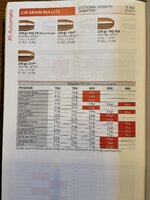Boy o boy, think I did something stupid.
I've been loading .45 ACP for years and not had any problems. I loaded a couple of thousand for my S/W 4506.
230 gr. FMJ ball, Winchester or CCI primer, 5.7 gr. of W231. Always shot great in the 4506. However in my HK45
that load seems too hot, more recoil than necessary, at least in my opinion. As I recheck the reloading data, seems
this load is off some charts. A couple of books calling for 4.4 to 5.5 gr. 231.
Do I need to pull all these bullets and start again?
Thank you.
I've been loading .45 ACP for years and not had any problems. I loaded a couple of thousand for my S/W 4506.
230 gr. FMJ ball, Winchester or CCI primer, 5.7 gr. of W231. Always shot great in the 4506. However in my HK45
that load seems too hot, more recoil than necessary, at least in my opinion. As I recheck the reloading data, seems
this load is off some charts. A couple of books calling for 4.4 to 5.5 gr. 231.
Do I need to pull all these bullets and start again?
Thank you.














